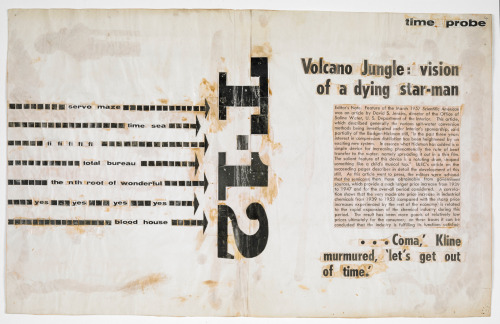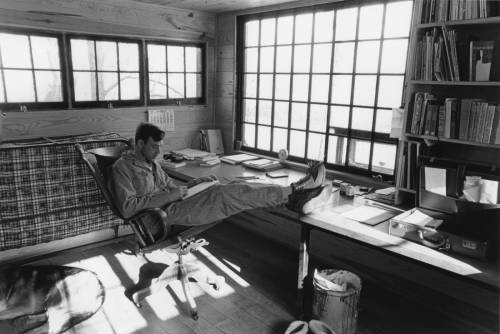#how we write
Kameelah Janan Rasheed: The Edge of Legibility | Art21 “New York Close Up”:
logo·phile | \ ˈlȯ-gə-ˌfī(-ə)l : a lover of words. A self-described “learner,” immersed in books since childhood, text-based artist Kameelah Janan Rasheed is uniquely fascinated with the written word and its power to both define and destabilize how we understand the world. Rasheed photocopies pages from books and printed materials, cuts out words and sentences, and re-arranges them in poetic, provocative, or even confusing combinations. The resulting sprawling wall collages, billboards, films and public installations encourage viewers to do the work of understanding. “It’s really an invitation,” says Rasheed, “Come think with me.” This short documentary film explores the artist’s expansive ideas and miniaturist process in her book-filled, Brooklyn home studio; the film’s exclusively close up style mirrors Rasheed’s own preoccupation with fragments, slowly building up a portrait over time.
From her studio, Rasheed sorts through stacks of childhood drawings and family photographs while recounting her father’s conversion to Islam in the early 1980s. His method of note taking, excerpting, and annotating inspired Rasheed’s own artistic practice. “I was thinking of this idea of talking back to a text,” says the artist, “Each time we read something, we’re annotating on the page or in our heads and creating a new text. It’s this act of collaboration between the reader and the writer.” At work on a new piece, Rasheed searches her books for specific shapes and styles of lettering, rather than particular words. She pieces together these fragments into longer phrases and sentences, intuitively creating combinations that code or complicate that which could be said plainly. Rather than jumping to understanding, viewers are invited to move more slowly and engage with works over and over again to create layers of meaning. For Rasheed, this approach also presents a powerful possibility for how we can publicly move through the world and create a kind of self-protection. “I think a lot about what it actually means to make myself legible,” says the artist. “How you present yourself to the world that’s legible and appealing to people, versus I’m not gonna make myself known until I’m ready.”
For more on Kameelah Janan Rasheed, see her website,a post from earlier this year, and this growing collection of bookmarks.
Kameelah Janan Rasheed lecture for RISD Graphic Design’s Spring 2020 Lecture Series
Why? See ALL THE TAGS (and, if only, the fifty plus more that got cut off when posting).
One of several old black and white photos illustrating Dorothy Wickenden’s profile of Wendell Berry:
In the “long-legged house,” a remote cabin with no plumbing or electricity, [Wendell] Berry has written fifty-two books, during breaks from farmwork and teaching.
Post link
#BeLongBíAnn The Story of a City (via Derek):
THE STORY OF A CITY
Roxanna Nic Liam
(i)
This is a story about a city.
This is a story about your city.
This is a story about the space that surrounds you
And the places around you.
The streets you walk on
The buildings you sit in, visit, live in or walk past without ever throwing back a glance.
The architecture that has you in awe
Or that you think is an eye sore.
The parks, the houses, the cobblestones,
The theatres, the red bricks, the very bones of the people who lived here.
This is a story about them.
About all the people who have ever lived here.
The good, the bad and the downright ugly.
This is their story.
And this is your story too.
(ii)
This is story that isn’t finished yet.
And hidden away somewhere,
Not in plain sight,
Is a place of incredible insight.
A place of books and and artefacts and diaries
And of endless knowledge-
Our Dublin Libraries.
But more specifically, the Dublin Archives.
A place that keeps the heart and soul of Dublin and it’s people alive.
A place that protects the history and mystery of our town.
It’s a treasure trove of ephemera
Archived and catalogued
From every era in Dublin
Going back centuries.
There are address books and almanacs and Nelson’s head on a much > humbler pillar
Newspapers from centuries ago found and bound
And stored away which may never see the light of day
until someone has the want or need to look at them.
And it’s the librarians,
These heroes of renown
Who protect the memories of this town.
Who catalogue every single thing that comes through their doors
They’re the ones
Finding and binding
Pamphlets and leaflets and programmes and flyers,
Their job is to collect, to gather, to care, to preserve and to share
To share with us
Because this is a story about your city,
Remember?
(iii)
This is a story about John Thomas Gilbert,
Who spent his life archiving,
Who spent his time diving into Dublin’s past,
Just because he could.
Not for profit or any kind of financial gain.
But because that was his passion.
He collected and gathered and cared for and preserved thousands and thousands of books and manuscripts and keepsakes for most of the 19th century.
And then,
He shared it with the people of Dublin.
He gave it back to the city,
To us,
So that we might have an insight into our past.
A legacy that will last.
So that we might know our own story,
Of those who came before us,
And pass it on to those who come after us.
He gave us an extraordinary gift,
Which still exists,
In a room,
In a library
In Dublin City Centre(iv)
This place
In the centre of Baile Átha Cliath
Is by no means a secret.
More like, a hidden gem.
A hidden gem, that’s full of hidden gems.
Available to you; to browse, to study, to glimpse in awe.
It is a public place,
That belongs to the citizens of this city.
Of this country.
And maybe you are not near The Gilbert Library.
But you might be near another library.
Full of it’s own hidden gems.
Maybe a gorgeous red brick beside a canal
Or a modern new build on a main road
Or a brutalistic construct in the middle of a housing estate
Or upstairs in an inner city shopping centre
Or some bookshelves on a bus that drives around.
Or maybe just a room in school somewhere.
These places are magical.
These spaces are sacred.
For everybody.
Old and young.
For whatever you need.
A place to read
A place to study
A place to learn a new language
A place to rent dvds
Or print out CVs
Or just sit down for a while
Somewhere where it’s quiet.
It doesn’t matter how you use it
It just matters that you do use it.
These spaces are for you.
They belong to you.
These places are full of stories.
And this,
This is a story about you.





